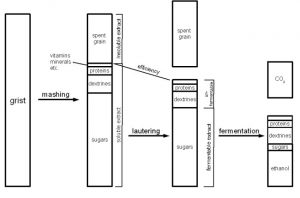Design
The design of beer is a fascinating subject. I have found the following guidance very helpful in learning this art.
 First of all, decide on the style of beer you would like to create. Look up your target beer style in the Beer Judge Certification Program (BJCP) style guidelines. The style guide has published ranges for bitterness, colour, original gravity, and alcohol by volume, as well as a description of the style, how it tastes, and key ingredients used. This is a bit of an American viewpoint, but does include the popular British styles.
First of all, decide on the style of beer you would like to create. Look up your target beer style in the Beer Judge Certification Program (BJCP) style guidelines. The style guide has published ranges for bitterness, colour, original gravity, and alcohol by volume, as well as a description of the style, how it tastes, and key ingredients used. This is a bit of an American viewpoint, but does include the popular British styles.
I also recommend looking at other recipes for your target beer style. There are huge repositories of beer recipes online you can search, for instance the HomebrewersAssociation.org beer recipe database or BeerSmithRecipes.com. These provide a great starting point.
Once you have a few sample recipes, sit down and compare them against each other to evaluate the ingredients used. Start with the grain bill for the mash, and take a look at which malts and grains the various brewers used, and how much of each. Converting the grain weights into percentages makes it easier to compare different recipes.
Next do the same with hops. What hop varieties did various brewers choose? How bitter did they make the beer? When should each hop be added to the boil?
And don’t forget that most important ingredient, yeast!
At this point you should have a good list of ingredients and a pretty good idea of the proportions to use. When building your recipe, there are three further fundamental considerations:
- Original gravity: The original gravity range gives a good indication of how much total malt is needed to brew the recipe.
- Colour: Colour is typically given in Standard Reference Method (SRM) units. Adding more dark malt to the malt bill will drive the colour estimate for the beer.
- Bitterness: Bitterness is expressed in International Bitterness Units (IBUs). You typically will adjust the quantity of hops used and hop boil times (the ‘hop schedule’) to reach the target bitterness level.
The Calculations page contains some basic design calculations that you might like to do. However, some essential calculations are quite complicated, so, for these, I have included a design worksheet, which does all of the calculations for you, and lets you play around with your recipe, until you get just the colour, strength and bitterness that you are looking for. The resulting recipe from the design worksheet may then be loaded into a log sheet, to use on your brewday. I find it really useful to keep a log sheet, just in case you come up with a great brew, that you would like to recreate in the future.
Additional Considerations
When building your first recipe from scratch, here are some other key concepts and common mistakes to consider:
- Aim for simplicity: Many inexperienced brewers take a “kitchen sink” approach and try to use too many varieties of grains and hops. This only muddies the recipe. Keep your recipe as simple as possible, and make sure each ingredient you add serves a specific purpose.
- Don’t overuse caramel & speciality malts: A typical grain bill should consist of 85 to 100 percent base malt. Speciality malts can easily overwhelm a recipe’s flavour and damage fermentability. Also, don’t overuse caramel malts, particularly those darker than 120 EBC, as doing so can impart harsh flavours to the beer.
- Use hops efficiently: Consider a single boil addition to achieve the target bitterness (IBU) level, and use flameout hops (hops added at the end of the boil) or dry hopping (hops added during a secondary fermentation) to add aroma for hoppy beer styles. This is usually the most efficient use of hops, as most aroma oils are volatile and boil off quickly.
- Don’t overdo techniques: While there are a number of advanced techniques you can apply, I recommend keeping your first few recipes simple. Use brewing techniques with which you are familiar to make a beer style you already understand. This will maximise your chance of success.
Incidentally, if you stick to a few basic rules, you can’t go far wrong – at the end of 2021, I had left overs from 11 malts and several hops. So I resolved to use most of the 11 malts, plus a few of the hops, and came up with a dark beer that was really tasty, which I named Mashup No. 1.
Good luck, happy brewing, and enjoy!
